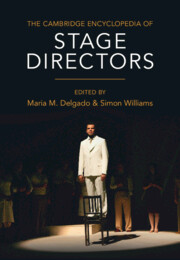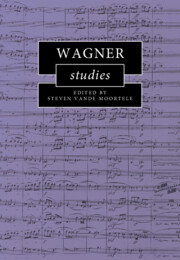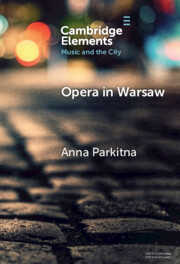Refine search
Actions for selected content:
131 results
26 - Decolonial Resonances in Czech Opera after 1948
- from Part III - The Twentieth Century and Beyond
-
-
- Book:
- A History of Music in the Czech Lands
- Published online:
- 21 October 2025
- Print publication:
- 16 October 2025, pp 363-379
-
- Chapter
- Export citation
9 - Bohemian Public Music Institutions and National Politics
- from Part II - The “Long” Nineteenth Century
-
-
- Book:
- A History of Music in the Czech Lands
- Published online:
- 21 October 2025
- Print publication:
- 16 October 2025, pp 131-143
-
- Chapter
- Export citation
6 - Music in Bohemian Royal Coronations and Opera in Prague in the Seventeenth and Eighteenth Centuries
- from Part I - Before 1800
-
-
- Book:
- A History of Music in the Czech Lands
- Published online:
- 21 October 2025
- Print publication:
- 16 October 2025, pp 87-99
-
- Chapter
- Export citation
13 - “The Very Bosom of our Nation”: The Dialectic of Folk and Art Music in Bedřich Smetana’s Hubička and Dvě vdovy
- from Part II - The “Long” Nineteenth Century
-
-
- Book:
- A History of Music in the Czech Lands
- Published online:
- 21 October 2025
- Print publication:
- 16 October 2025, pp 186-198
-
- Chapter
- Export citation
Chapter 35 - Performing Michael Field
- from Part V - Afterlives and Future Fields
-
-
- Book:
- Michael Field in Context
- Published online:
- 03 October 2025
- Print publication:
- 25 September 2025, pp 333-339
-
- Chapter
- Export citation
Chapter 27 - Schoenberg’s Performers
- from Part VII - Performers and Critics
-
-
- Book:
- Schoenberg in Context
- Published online:
- 04 September 2025
- Print publication:
- 04 September 2025, pp 267-275
-
- Chapter
- Export citation
Chapter 25 - Theatre
- from Part VI - Viennese Institutions
-
-
- Book:
- Schoenberg in Context
- Published online:
- 04 September 2025
- Print publication:
- 04 September 2025, pp 250-257
-
- Chapter
- Export citation
A Genre in Flux: Grand opéra Through the Lens of French Touring Companies, 1830–1860
-
- Journal:
- Cambridge Opera Journal , First View
- Published online by Cambridge University Press:
- 01 September 2025, pp. 1-24
-
- Article
-
- You have access
- Open access
- HTML
- Export citation
Universal in Scope and Appeal? The Politics of ‘National’ vs ‘International’ Opera at Post-war Covent Garden
-
- Journal:
- Transactions of the Royal Historical Society , First View
- Published online by Cambridge University Press:
- 07 July 2025, pp. 1-24
-
- Article
-
- You have access
- Open access
- HTML
- Export citation

The Cambridge Encyclopedia of Stage Directors
-
- Published online:
- 19 June 2025
- Print publication:
- 03 July 2025
Chapter 5 - Italy
- from Part I - Life and Death
-
-
- Book:
- Percy Shelley in Context
- Published online:
- 17 April 2025
- Print publication:
- 24 April 2025, pp 34-40
-
- Chapter
- Export citation

Wagner Studies
-
- Published online:
- 17 April 2025
- Print publication:
- 24 April 2025
The Profiteers of Slavery Go to the Opera: London, 1782–1808
-
- Journal:
- Cambridge Opera Journal / Volume 37 / Issue 1 / March 2025
- Published online by Cambridge University Press:
- 04 April 2025, pp. 1-26
-
- Article
-
- You have access
- Open access
- HTML
- Export citation

Opera in Warsaw
- A City of the European Enlightenment
-
- Published online:
- 27 November 2024
- Print publication:
- 19 December 2024
-
- Element
- Export citation
‘Du Paradis Rêvé’: Parodies of Japonisme in Saint-Saëns's La princesse jaune
-
- Journal:
- Cambridge Opera Journal / Volume 36 / Issue 3 / November 2024
- Published online by Cambridge University Press:
- 14 November 2024, pp. 295-313
-
- Article
-
- You have access
- Open access
- HTML
- Export citation
Chapter 3 - The Culture of Improvement and “Great Expences”
-
- Book:
- The Business of English Restoration Theatre, 1660–1700
- Published online:
- 18 October 2024
- Print publication:
- 13 June 2024, pp 95-126
-
- Chapter
-
- You have access
- Open access
- HTML
- Export citation
10 - Composing for the Stage
- from Part II - Techniques
-
-
- Book:
- The Cambridge Companion to Composition
- Published online:
- 25 May 2024
- Print publication:
- 30 May 2024, pp 153-163
-
- Chapter
- Export citation
8 - Composing for Voice
- from Part II - Techniques
-
-
- Book:
- The Cambridge Companion to Composition
- Published online:
- 25 May 2024
- Print publication:
- 30 May 2024, pp 120-138
-
- Chapter
- Export citation
Thomas Clayton’s Arsinoe (1705) Reconsidered: An English Opera in the Italian Manner
-
- Journal:
- Royal Musical Association Research Chronicle / Volume 55 / April 2024
- Published online by Cambridge University Press:
- 27 May 2024, pp. 30-51
-
- Article
- Export citation
Chapter 23 - Composing for Opera and Theatre outside Established Genres
- from Part V - The Music of Debussy’s Time
-
-
- Book:
- Debussy in Context
- Published online:
- 23 May 2024
- Print publication:
- 23 May 2024, pp 211-219
-
- Chapter
- Export citation
